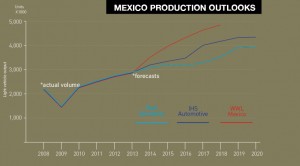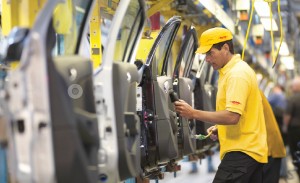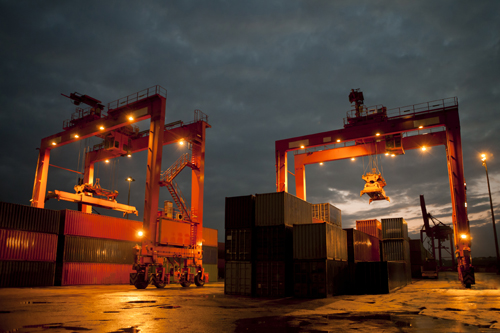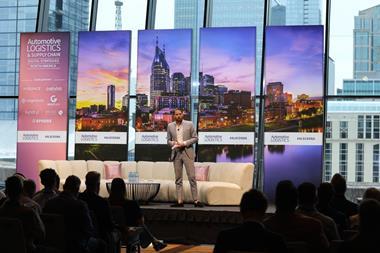Logistics is part of what has helped carmakers succeed in Mexico’s historically difficult economy, but will it be an advantage or pitfall in future?
This special multi-part report, by editor Christopher Ludwig, explores Mexico’s historic and developing supply chain as well as the logistics challenges connected with what is expected to be an unprecedented boom in vehicle production and exports.
Below find links to other stories in this special report:
And the following stories on finished vehicle logistics in Mexico:
Although there is much buzz today about Mexico attracting investment from carmakers, the industry has a long and complicated history in the country. The Mexican government has made active attempts to develop the sector for more than 50 years, since it started to issue ‘Automotive Decrees’ regulating production, suppliers and imports. These helped entice Nissan and VW to set up some of their first international factories in the 1960s, with Detroit carmakers following later as rules around supplier ownership and content slowly loosened. The decrees are still issued, setting minimum targets in output and local content for carmakers in exchange for duty exemptions and customs privileges.
A series of economic and currency crises eventually pushed Mexico toward trade liberalisation in the 1980s; the value of automotive parts exchanges, in particular with the US, increased rapidly. The North American Free Trade Agreement (NAFTA) in 1994 began to strip away many barriers, opening Mexican plants fully to investment and equipment modernisation. Light vehicle output grew from 1.05m units in 1993 to around 1.9m by the end of the millennium.
Economic issues meant it would take another seven years for output to reach 2m, but by 2007-2008 Mexico’s competitiveness and capabilities for small cars made it a hot spot even as carmakers shuttered plants in the US and Canada. Around that time, Ford announced it would build its first ‘global’ car, the Fiesta, in Mexico, while China’s FAW unveiled plans to build a factory in the country.
The ensuing global crash and Detroit bankruptcies turned back the clock yet again, with the Mexican industry devastated by the collapse of the US market and the economy undermined by drug cartel-related violence. By 2009, car production had fallen nearly 30% from its recent highs. The Chinese and other investors pulled back. For many in Mexico, the oft-quoted words of a 19th century Mexican president, Porfirio Diaz, were again appropriate. “Poor Mexico, so far from God, so close to the United States.”

However Mexico, perpetually caught between the rich and poor, success and collapse, rebounded spectacularly. Production losses were entirely regained by 2010 and reached a record 2.93m units last year, including 2.42m exports. Despite its ups and downs, two decades of NAFTA have helped bring a huge increase in value to the Mexican supply chain. The total value of vehicles and parts trade between Mexico to the US last year surpassed $102 billion, compared to $18.6 billion in 1993 (see table).
Mucho más to come
While production and trade are at all-time highs, the real excitement for Mexico is still over the future. Forecasts for vehicle production range for growth of 30-50% between 2013 and the end of the decade. The latest forecast from PwC Autofacts sees light vehicle production increasing to nearly 4m units by 2020, while IHS Automotive expects nearly 4.5m. Wallenius Wilhelmsen Logistics (WWL), which has ocean and inland distribution operations in Mexico, predicts Mexico’s total vehicle assembly will reach 4.88m units by 2018, including 4.26m exports.
The roll call of recent investments for this latest Mexican wave includes American, Japanese and European OEMs. Those with existing operations have poured billions into plants to bring new products to Mexico, including lower cost cars like the Ford Fiesta, but also upmarket Ford Lincoln and GM Cadillac models.
Mexico was also among the first markets in which Fiat and Chrysler were notably combined; in 2011 the Fiat 500 came to Chrysler’s Toluca plant, outside Mexico City, and more recently the company invested $1.2 billion in Saltillo, in the northeast close to Monterrey, to build the Ram ProMaster (a Fiat-derived van) and to upgrade a powertrain factory to build the Tigershark four-cylinder engine. Last year, the company built more than 1m engines in Mexico (most for export).
Two years ago, the Volkswagen Group added a new engine plant in Silao, 350km from Mexico City in Guanajuato state; earlier this year it also brought the new Golf to its massive plant in Puebla, east of Mexico City.
New capacity is now coming online. Nissan will eventually spend $2 billion on its second plant in Aguascalientes, in central Mexico, the first phase of which opened last November, raising the carmaker’s annual capacity in Mexico to 850,000 units. At the end of June, Renault Nissan and Daimler announced that they would be extending their global partnership by adding yet another plant in the vicinity of the existing plants at Aguascalientes, which will build Nissan's premium Infiniti model by 2017 and Mercedes-Benz passenger cars by 2018. The joint venture is expected to have annual capacity of 300,000 vehicles when fully ramped up by 2021.
Earlier this year, Honda opened a 200,000-unit per year factory in Celaya for the new Fit, in Guanajuato state, where it is also building an engine and transmission plant, and which also has plenty of room for expansion. Mazda has opened a 140,000-unit factory in nearby Salamanca that will eventually build a Toyota model. By 2016, Audi will open a 150,000-unit per year plant in San José Chiapa, not far from its first factory in Puebla state, which will be the global production site for the Q5 SUV.
Mexican whispers
Rumours and speculation of new entrants mount every week. BMW has said that it will confirm a new North American location this summer, with several sources indicating that it is likely to be in Mexico. Should that be the case, Mexico could be crowned the major production hub for luxury vehicles in North America as it will be build Audi, Mercedes-Benz and BMW, as well as Infiniti, Cadillac and Lincoln. The implications of this growth in premium production is significant not only for volume, but also for the supply base, as more component manufacturers follow their customers to Mexico.

One executive reveals that his company has carried out studies for a consultant representing a Korean carmaker, which follows rumours that Hyundai is eyeing capacity in Mexico. Hyundai recently took control of its own distribution network in Mexico, which Chrysler had previously managed.In future, Mexico may again be a destination for a Chinese carmaker looking to establish a footprint in North America.
Further changes are likely to integrate Mexico with the US market and supply chain even more deeply. Last year, Ford started sharing production between the US and Mexico when it added the Fusion at its Flat Rock, Michigan plant to compliment output at Hermosillo in the northwest of Mexico, which is increasing the carmaker’s cross-border material flow. There is currently speculation that Ford will change its production mix further in Mexico.
Finally, there are rumours that Fiat Chrysler will consolidate the Fiat 500, currently built for the Americas in Toluca, in Poland by 2016, as well as move the Dodge Journey/Fiat Freemont from Toluca as well. Press and analyst reports have speculated that Toluca will be retooled to build a Jeep product, which Fiat Chrysler is aggressively pushing as a global brand.
While officials at BMW, Hyundai, Ford and Fiat Chrysler decline to confirm the above, if even half of these predictions come to pass, Mexico will likely remain one of the world’s fastest growing major production bases. Only China seems likely to rival it for volume increases.
Automotive logistics strength in Mexico…for now
What is driving all of the investment? Labour costs, which have stagnated for a decade at around $2-$5 per hour for assembly line workers, are certainly helping. However, Mexico’s logistics links to the north of the Rio Grande may count for at least as much, following the recovery of sales in the US and Canada. On the whole, manufacturers have sought more manageable supply chains, including reduced currency exposure and lower shipping costs. Mexico comes out ahead on these grounds.  Sofia Garcia, logistics service purchasing manager at the Renault-Nissan Purchasing Organisation, responsible for logistics purchasing for Mexico, points to more than 40 free trade agreements between Mexico and other countries, its rail links to the US, and global port connections, including for South American markets. Few countries have as competitive an export location and conditions as Mexico for serving a regional and global supply chain, she says.
Sofia Garcia, logistics service purchasing manager at the Renault-Nissan Purchasing Organisation, responsible for logistics purchasing for Mexico, points to more than 40 free trade agreements between Mexico and other countries, its rail links to the US, and global port connections, including for South American markets. Few countries have as competitive an export location and conditions as Mexico for serving a regional and global supply chain, she says.
Mexico also benefits from a strong supplier base and a growing engineering cadre well integrated with the US. Ford Motor Company, for example, had 50 engineers in Mexico in 2005; today it has more than 1,000. “For Mexico, you have a strong local supply base, with many suppliers within 200km of plants, as well as being close to the US,” says Rafael López, the company’s material planning and logistics director for Mexico. “This is important for logistics, but also for managing engineering changes and problem solving, as you avoid delays and obsolescent parts.”
Despite these strengths, Mexico shares the logistics woes of other emerging markets. The World Bank Logistics Performance Index ranks it 50th globally, well behind China at 28th and several places ahead of India at 54th. It scores poorly for customs and average for issues like infrastructure and logistics competence. A drive through its sprawling capital and environs, with a confusing and traffic-clogged network of circling flyovers and myriad toll roads, only hints at the difficulty of getting places on time. Security is a serious issue, with cargo theft and damage rates among the world’s highest.

Likewise, more than 70% of the vehicles produced in Mexico move by rail for export direct to the US and Canada or to ports, with electronic clearance for customs common. Ferromex alone expects to move 2m vehicles and 50,000 containers this year for the automotive industry, according to its assistant vice-president for automotive, Alberto Sanchez. China and Russia, whose governments have showered investment and protection upon its railways, move only 5-10% of vehicles by rail, and hardly any parts. In Brazil, rail and intermodal are non-existent for automotive beyond some knockdown kits. According to an OECD study, the costs of Mexico’s two main railways – Ferromex and Kansas City Southern de Mexico (KCSM) – are ranked lowest in Latin America and are competitive relative to their North American peers. Despite a current bill in the Mexican government that proposes to change rules on railway concessions, Sanchez says the railways have good support at federal and state-government levels in Mexico.
“Rail has become a competitive advantage for the country, since Mexico is an active part of the North American rail network,” says Sanchez.
Julie Luna, chief commercial officer for XPO Logistics, which earlier this year acquired Pacer Logistics and is the largest cross-border provider for Mexico, says intermodal border crossings are essentially “seamless”, with run-through trains and shipments that clear the destination rail ramp. The company is expecting high double-digit growth for automotive cross-border business in 2014.
Daniel Saenzpardo, director of logistics for Nissan Mexicana, agrees that rail services, especially for vehicles, are one of Mexico’s competitive advantages. “Right now rail transportation is by far one of the most competitive options due to volume capacity, lead times and efficiency,” he says.
Nissan’s Sofia Garcia maintains that Mexican logistics also has advantages for its labour supply and performance. “It is not just about low labour costs for manufacturing. We are also competitive for tier suppliers as well as transport costs,” says Garcia. “For example, while in the US there is a truck driver shortage, in Mexico we find very qualified drivers.”
Mercedes Figueroa, head of logistics and customs at Fiat Chrysler Mexico, says the company’s supply chain is very efficient, with inbound on-time pick-up and delivery rates at 95%, while the accuracy of estimated times of arrival for vehicles in Mexico is 97%. Load factors are high: more than 90% for truck and up to 97% for rail and intermodal. “Intra-Mexico, we are extremely competitive for rates in truck transportation,” she says. “In recent years we have invited other Mexican carriers working with OEMs to compete for our business, but they have struggled to access our rates.”
GM’s Swiss also points out that the carmaker moves most freight between the US, Canada and Mexican using returnable packaging. The same is true for Nissan. Although the distances are long, which often works against returnable equipment, the high volume and frequency of border flows make such loops feasible.
"In recent years we have invited other Mexican carriers working with OEMs to compete for our business, but they have struggled to access our rates" - Mercedes Figueroa, Fiat Chrysler
The flipside of growth
While Mexico has advantages for logistics, virtually everyone has concerns about whether transport infrastructure and services will keep up with the increase in production and exports. “We see many more OEMs coming into Mexico, but we fear that the infrastructure is not going to expand at the same rate of growth,” says Ford’s López. “We have concerns across rail, ports and roads.”
Fiat Chrysler’s Figueroa agrees. “The key challenge is to balance additional demand with supply by making new capital investments, including equipment, such as trucks and railcars, but also the underlying infrastructure, mainly for road and rail,” she says.
The worries are in some ways most obvious for outbound logistics, particularly over rail capacity for exports and short-sea shipping services (see finished vehicle sections of this report on Mexico). “Despite rail’s advantages, we have an area of opportunities regarding railcar capacity [for vehicles],” says Saenzpardo. “The total pool of equipment in North America may not be growing according to the volume demand.”
However, José Luis Garcia, vice-president of automotive at DHL Supply Chain Mexico, says the country also has a real estate shortage, including for high quality warehouse space and particularly for quality crossdock facilities. He warns that infrastructure investment lags manufacturing growth.
“It is going to mean more congestion. We need more ramps for train loading, for example,” he says. “The government has put forward an aggressive investment and development programme, but we have to wait and see that it is really implemented – and by when. For example, it only recently announced that it would double the size of the port of Veracruz, but that is going to take years to finish.”

Providers seem to get the message about the need for investment, but there are concerns that manufacturers make capacity demands, but don’t then match them with volume, especially with so many plants in unpredictable launch phases. Nevertheless, Sanchez says Ferromex has made investments that the company is confident will meet automotive demand. Manufacturers are watching carefully to see if he is right.
What would you pay to grow?
There are other cost and productivity issues in Mexico. With Mexico a net importer of oil, the government is withdrawing fuel subsidies, which will push up prices every month for the next three years. Costs and delays are also increasing along the country’s toll roads. “We need to get support and understanding from the government to help us find a strategy to deal with these issues,” says Sofia Garcia.
The growth has exposed gaps in skills and qualified labour. Sergio Gutierrez, head of Mexico for WWL, which has grown from 150 to more than 1,000 employees in the country over the past seven years, says it is common for companies to poach talent from one another. “We have a big challenge keeping the right people with the right skills,” adds Gutierrez, who has worked in the sector for around 18 years. “Everyone is always trying to steal the best from one another.”
Garcia identifies similar problems for DHL, which is the largest contract logistics provider in Mexico. He says there is a lack of training in logistics management within companies and at universities in Mexico. “Only a few people have degrees in these areas and we have to train employees in our different specialisations,” he says. “We need to work on growing the knowledge network in Mexico.”
"We see many more OEMs coming into Mexico, but we fear that the infrastructure is not going to expand at the same rate of growth" - Rafael López, Ford
As one approach, Gutierrez says WWL is considering changing the balance between temporary and permanent labour. To deal with seasonality, the company traditionally uses a 40:60 mix of permanent and temporary staff. “Now we are looking at increasing to an 80:20 mix in favour of permanent employees,” he says. “It will be challenging because we still need flexibility, but what is worse, to lose talent, or to focus resources on finding better ways and thinking outside the box?”
Nissan, WWL’s biggest customer, is taking a similar approach, says Chris Styles, senior director of logistics for Nissan North America. “Our growth helps us to provide more incentives and if employees perform they can be promoted to a more permanent type of position.”
Tale of two Mexicos
Not all of Mexico’s problems are down to growing pains. Cargo damage, theft and vandalism are high in parts of the country, particularly for finished vehicles at points of rest or delay. Manufacturers, providers and the government are working to prevent this – with CCTV monitoring, extensive auditing and controls on driver routes and refuelling points – but it adds cost and time to the supply chain.
The Mexican economy is also generally weak, with small-and-medium sized companies underperforming in particular. A recent McKinsey report warned of the growing gap between two Mexicos: one high-tech, with sophisticated plants that compete globally; the other sub-scale, low-speed and operating mainly outside the formal economy. While major automotive manufacturers are part of the first Mexico, some areas of logistics – including a fragmented truck carrier base – can often be found in the second.
DHL’s Garcia points out that in Mexico, a foreign-registered company cannot own trucks larger than around five tonnes, and so must work with local partners. One difficulty is that deliveries across parts of Mexico, such as the northwest and southwest, are low density across long distances. He also highlights security and safety considerations when choosing partners. “There are lots of small-and-medium sized carriers out there and you have to be careful about who you choose in order to provide a safe and high-quality service,” he says.
Gilles Cudia, managing director of Gefco Mexico, which is new to the Mexican market, agrees it is important to screen drivers and companies carefully, and make sure licences, equipment and insurance are valid and to the right standard. His worry, however, is that fast growth could compromise these processes. “Customers want more and more quality, but the market is growing fast and if companies cannot keep up, the priority might be to put trucks on the road before doing the proper checks,” he says.
Land of opportunity
Mexico is no beginner’s logistics market. There are strong international automotive 3PLs, along with competitive Mexican providers. Chris Styles says that while overall logistics costs are comparable to the US, the quality of service in Mexico can be even higher. “I think the Mexican carriers are often as good or even better than some in the US, particularly around areas like visibility and security because of the requirements in Mexico,” he says.

Mexico may even offer more scope for 3PLs than elsewhere. Regulations require companies to pay more social security costs and guarantee hours for permanent workers, however Mexico’s production has high seasonal variation. This pushes companies toward third parties that act almost as labour agencies, using more temporary workers for data and administrative tasks as well as labour-intensive warehousing, in-plant logistics, yard management and accessory installation.
On example is at Ford, which uses a mix of providers across Mexico. In Hermosillo, the carmaker has even outsourced its sequencing centre to Seglo, which prepares and stages material, before delivering to DHL Supply Chain, which manages in-plant logistics. “It was difficult in the beginning, but both suppliers learned to work as a team in order to fulfil requirements; today it works very well and has become an industry benchmark,” says López.
Not everyone has rushed into the 3PL market, however. Nissan has large logistics operational and engineering teams in Aguascalientes and Tennessee to manage and design its inbound and parts logistics services, with only around 2% of these operations procured through a 3PL, according to Garcia, such as brokerage for cross-border flows (it’s different for outbound, where Nissan uses WWL as a 3PL).
“Over the years we have maintained more logistics expertise in-house, including for US and Mexico domestic and cross-border flows,” says Styles. “We use 3PLs only for certain services like route engineering or providing labour at crossdocks.”
Nissan is also relatively unique in Mexico for running in-plant logistics with its own staff. Fiat Chrysler, following processes from its World Class Manufacturing programme, has also taken in-plant logistics in-house, according to Figueroa, including supermarket management and kitting.
Ferromex mostly works directly with OEMs for finished vehicles; for intermodal it has a subsidiary, IMEX, that provides door-to-door services and crossdocking; it also works with the major intermodal providers in North America.
DHL’s Garcia believes that a large portion of the Mexican market is still untouched by 3PLs, including many tier suppliers. “Some of these companies take direct control of their logistics needs,” he says. “We want to extend our relationships, especially to these medium-sized companies.”
Gefco’s Cudia has found some companies in Mexico, especially outside the automotive sector, unfamiliar with outsourcing to 3PLs. When Gefco sent a subcontracted truck to a Mexican plant for a large, fast-moving consumer-goods company, gate workers wouldn’t initially let the truck through. “They had no record of the delivery and the plant didn’t think to check that it was from Gefco rather than the subcontracted brand. That tells me these guys are not so used to working with providers like us,” he concludes.
Even a somewhat low 3PL uptake demonstrates the opportunities for Mexico’s logistics. At the top end, in First World, blue chip Mexico, the likes of Nissan, Ford, GM, Fiat Chrysler and global tier ones want more sophisticated logistics, from intermodal to just-in-time deliveries. However, logistics providers will have to make sure they can meet the needs of smaller companies too, and avoid slipping into the slower, unproductive, more volatile Mexico.






































